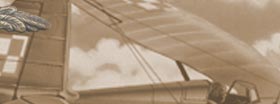Market Garden: The Island
By Tim Saunders, Barnsley. Leo Cooper imprint of Pen & Sword Books.
ISBN 0 85052 861 5
Market Garden: Nijmegen
By Tim Saunders, Barnsley. Leo Cooper imprint of Pen & Sword Books.
ISBN 0 85052 815 1
Both books are part of the impressive Battleground Europe series that are designed for battlefield tours. The format consists of annotated wartime maps and photos with personal accounts to enrich the readers' experience of Saundersí's narrative.
Nijmegen recounts XXX Corps route - some sixty-four miles from Belgium through southern Holland as part of operation MARKET GARDEN. This volume sets the scene with an overview of GARDEN and its objectives. While General Montgomery's plan may have been 'imaginative', leaving the operation to Lieutenant General 'Boy' Browning whose poor relationship with other commanders, notably the US General Lewis Brereton and the Polish Brigadier-General Sosabowski, clearly impacted upon the overall command and its effectiveness. The decision to land the 'bloated' tactical headquarters near Nijmegen remains a questionable decision. Poor communication systems with geographically dispersed units in the battlefield eventually 'neutered' the operation. To the north of Nijmegen lay open farmland not suited to 'tankers' and the decision to move the 43rd Wessex Division through blocked roads under constant fire probably came too late to save operation MARKET. Their adversary however, made up of German paratroops and units of the 9th SS Division demonstrated tactical flexibility and superiority with doggedness that hampered the operation despite being under strength and full battle ready.
Saunders sets out Nijmegen in ten clear chapters to cover the operation and directions on how to follow the battle with useful travel information included. The detailed narrative leads the reader along the route in a chronological order where the maps and photos interspersed with personal accounts assist in setting the scene of battlefield.
The Island recounts the next phase of GARDEN and the planned advance from Nijmegen towards Arnhem. This volume covers events that are often overlooked and yet crucial to understanding the failure to meet all the objectives of MARKET GARDEN. Geographically the area is flat low-lying polder sandwiched between the Rhine and the Waal rivers. XXX Corps inertia to dash to Arnhem had been caused by insufficient combat power through re-supply of appropriate units and munitions to achieve their objective. Poor air support and artillery coverage made action in this landscape at times similar to the Great War.
The chapters follow the road to Arnhem and the misplaced use of the Polish Parachute Brigade's drop onto Driel followed by the evacuation of 1st Airborne. The less covered action at Elst, Randwijk and Opheusden are detailed accounts often overlooked in more generalized texts. The battle for Aam-Bemmel highlights the role of the 50th Northumbrian Division who had suffered considerably after being engaged in most theatres of the war. The battle for Aam-Bemmel was tough and highlights increasingly outmoded tactics used by British infantry in the field.
While this volume is a great military read, the lack of detail regarding the Polish Parachute Brigade's role seems to centre on personality clashes with Sosabowski. The British conference at Valburg was aimed at marginalizing Sosabowski and reducing criticism of inadequate planning and poor logistics. It is at this point Saunders appears to support the continued established view by British military historians. Sosabowski was critical of the operation and was fully aware of the disaster facing the Poles even before they jumped into Driel. Much has been done to 'rehabilitate' Sosabowski and Polandís contribution as Britain's First Ally in recent years. The failure of MARKET GARDEN and the strategic decision not to free Antwerp left the Dutch nation facing the most appalling conditions under a hardened attitude and regime by the Germans - this should not be forgotten too.
Julian Hoseason, editor polandinexile.com





